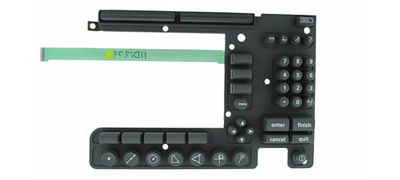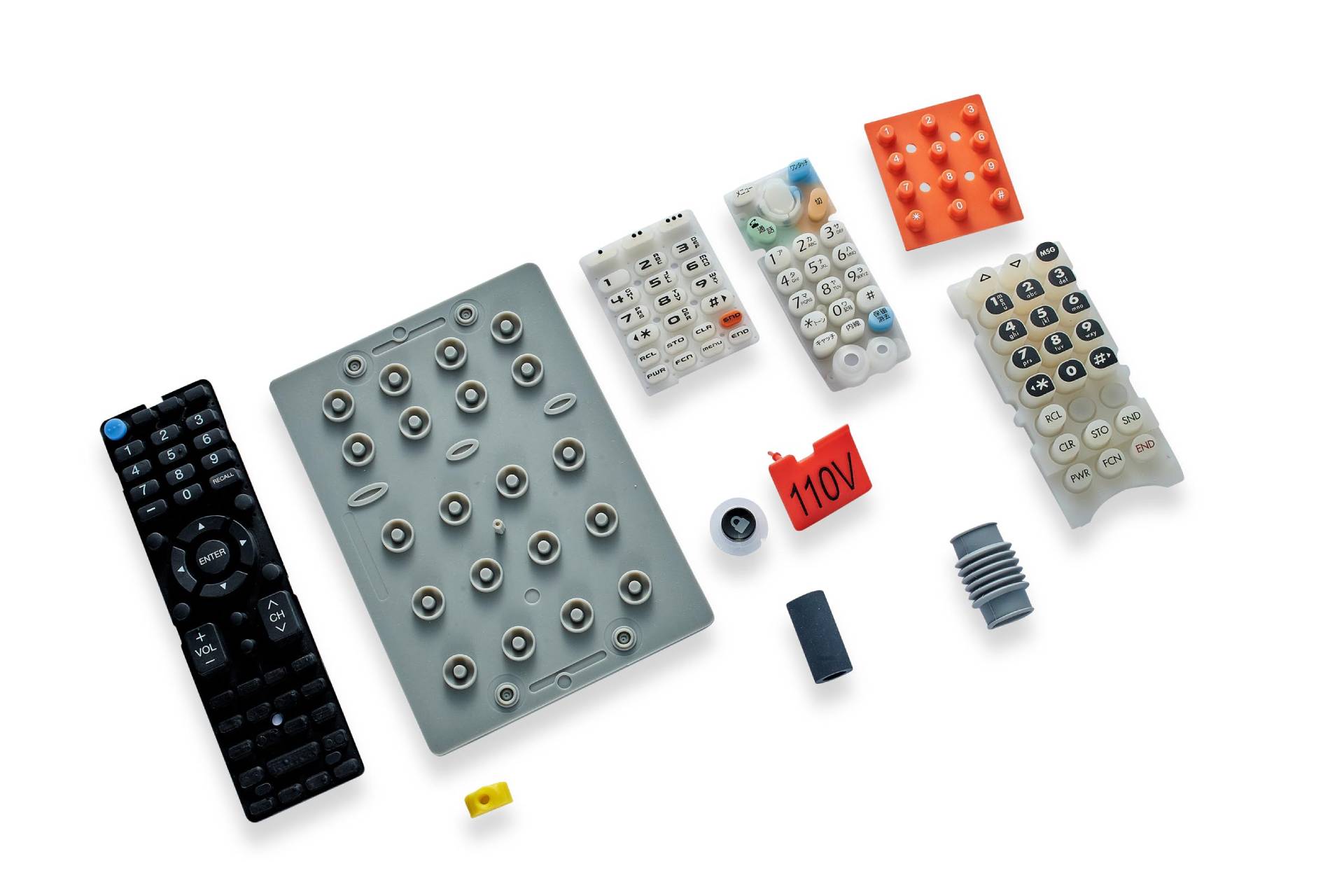Why backlit Rubber Keypads are gaining popularity in modern devices
A Comprehensive Guide to the Manufacturing and Handling of Rubber Keypads for Ideal Efficiency
The production and handling of rubber keypads play a necessary role in their performance and usability. Material selection, layout accuracy, and innovative manufacturing strategies considerably impact their sturdiness and performance. Comprehending these components is crucial for developing high-grade items. As various advancements emerge in this area, discovering their implications can reveal new criteria for capability and customer experience. What essential facets will shape the future of rubber keypads?
Understanding Rubber Keypads: Products and Types
Rubber keypads are important parts in numerous devices, offering an equilibrium of toughness and responsive responses. These keypads are largely made from silicone or artificial rubber, products selected for their versatility and resilience. Silicone rubber, particularly, is favored for its superb temperature level resistance and longevity, making it ideal for different applications, from customer electronic devices to commercial machinery.
There are several kinds of rubber keypads, including dome button keypads, which use a dome-shaped mechanism that provides responsive feedback when pressed. Furthermore, there are also level keypads, which include a smooth surface and are frequently used in push-button controls and clinical tools. The selection of material and type affects the keypad's performance, feel, and overall individual experience. Recognizing these aspects is crucial for designers and suppliers intending to develop effective and trusted user interfaces in their products.
The Production Refine: From Design to Production
The production process of rubber keypads includes several crucial stages, beginning with style and finishing with manufacturing. Originally, designers create thorough requirements and models, guaranteeing the keypad meets functional and aesthetic demands. Computer-aided style (CAD) software program is frequently made use of to picture the design and functions before continuing.
When the layout is settled, material option is essential, with choices generally consisting of silicone or all-natural rubber. In the next stage, mold and mildews are produced based on the authorized designs, which will shape the keypads throughout manufacturing.
Complying with mold and mildew development, the manufacturing stage commences, where rubber is blended with additives to boost performance. The combination is after that poured into mold and mildews and based on warm and stress, allowing it to strengthen and treat.
Ultimately, the finished keypads undertake top quality checks to validate they fulfill established criteria, adhered to by product packaging for circulation. This all-encompassing procedure guarantees peak performance in the final item.
Trick Methods in Rubber Molding
In the domain of rubber keypads, numerous molding strategies play a pivotal function in identifying the high quality and capability of the end product. One common approach is compression molding, where raw rubber is placed in a warmed mold and pressure is applied, permitting effective mass manufacturing and harmony. Another considerable strategy is shot molding, which involves injecting heated rubber right into a mold, providing better accuracy and complex forms. Transfer molding, a crossbreed of both approaches, is likewise used, specifically for intricate styles, as it combines the advantages of both procedures. Furthermore, fluid silicone rubber (LSR) molding is obtaining grip as a result of its flexibility and resilience, making it ideal for high-performance applications. Each technique possesses one-of-a-kind attributes, influencing aspects such as cycle time, material waste, and production prices. Selecting the proper molding strategy is vital for achieving peak performance in rubber keypads.
Surface Finishing and Texturing Options
Surface area ending up and texturing options play a necessary role in enhancing the tactile experience and visual appeal of rubber keypads. Makers utilize different methods to develop distinct surface features that impact user interaction and product style. Typical finishing techniques include matte, glossy, and satin finishes, each offering different aesthetic effects and grasp degrees. Texturing choices, such as elevated patterns, grooves, or stippling, better enhance capability by enhancing traction and decreasing slippage throughout usage.
In addition, certain appearances can be customized to meet ergonomic needs, supplying convenience during prolonged use. The selection of surface area coatings and appearances can be affected by the desired application of the keypad, whether it be for consumer electronic devices, automobile controls, or commercial tools. Eventually, careful consideration of these alternatives adds substantially to customer satisfaction and overall item efficiency, making them important elements in the layout and production process of rubber keypads.
Quality Control Actions in Rubber Keypad Manufacturing
Quality assurance actions in rubber keypad manufacturing are critical for making certain item integrity and efficiency. These procedures include product choice requirements, rigorous testing treatments, and stringent final assessment standards. With each other, they create a thorough structure that aids suppliers copyright quality throughout the production procedure.
Product Selection Criteria
Choosing the suitable materials for rubber keypads is important, as it straight affects their customer, performance, and toughness experience. Secret requirements for material option consist of tensile stamina, durability, and environmental resistance. The choice of rubber substance, such as silicone or polycarbonate elastomer (TPE), plays a critical role in achieving wanted tactile feedback and durability. In addition, variables like chemical compatibility, temperature level stability, and UV resistance should be taken into consideration to ensure optimal efficiency in different applications. Makers need to additionally examine the simplicity of processing and cost-effectiveness of products, stabilizing quality with budget constraints. Eventually, the best product option not only boosts the keypad's efficiency however additionally adds to general item quality and consumer satisfaction.
Checking Procedures Applied
After figuring out the suitable materials for rubber keypads, strenuous testing procedures are implemented to validate that the last items fulfill industry standards and customer assumptions. These procedures generally consist of mechanical screening, which reviews the toughness and flexibility of the rubber under various conditions. Furthermore, environmental screening examines the keypads' efficiency under temperature level fluctuations, humidity, and direct exposure to chemicals. Electric screening validates the keypads function correctly with electronic components, confirming responsiveness and conductivity. Additionally, tactile feedback is assessed to ensure user satisfaction. These comprehensive screening procedures are vital in determining any defects or disparities before automation, inevitably improving the integrity and performance of rubber keypads in their desired applications.

Final Examination Criteria
Thorough last evaluation criteria are critical in rubber keypad manufacturing to ensure that each unit meets the specified standards for capability and appearance. This procedure normally involves visual assessments to identify any type of surface flaws, such as discoloration or blemishes. Additionally, tactile evaluations ascertain that the keypads respond accurately to touch, preserving the called for degree of level of sensitivity. Sturdiness tests might also be performed, replicating prolonged use to verify the long life of the keypad under various problems. Adherence to market policies and customer specs is verified to maintain high quality guarantee. By carrying out these rigorous evaluation actions, makers can substantially minimize the danger of issues, guaranteeing that the final item is trusted and satisfies consumer expectations, inevitably boosting customer contentment.
Technologies in Rubber Keypad Modern Technology
As innovation proceeds to progress, advancements in rubber keypad innovation are reshaping customer interfaces across numerous industries. One considerable development is the assimilation of capacitive touch sensors within rubber keypads, enabling an extra versatile and responsive customer experience. This technology allows individuals to engage with devices with touch, enhancing capability without giving up the tactile feedback that rubber keypads are understood for.
Additionally, improvements in material solutions have actually caused the growth of more durable, weather-resistant rubber, making keypads suitable for outside and industrial usage. Enhanced printing strategies additionally permit high-resolution graphics and backlighting alternatives, raising visibility and aesthetic charm.

Developments in making procedures, such as 3D printing, are enabling custom-made layouts and fast prototyping, streamlining manufacturing timelines. important source These advancements collectively add to extra effective and user-friendly rubber keypads, ensuring they meet the needs of modern applications while keeping their core advantages.
Best Practices for Layout and Functionality
Creating efficient rubber keypads needs mindful analysis of both visual appeals and performance. Rubber Keypads. A properly designed keypad ought to balance ergonomic principles with aesthetic attract improve customer experience. blog Key elements consist of dimension, shape, and spacing of buttons, ensuring they are simple to press while stopping unintended activation. Utilizing contrasting textures and shades can boost presence and responsive feedback, aiding users in comparing tricks
Furthermore, the option of products plays an important role; premium rubber substances can enhance durability and resistance to put on. It is likewise essential to take into consideration the combination of functions such as backlighting and personalized graphics, which can boost functionality in numerous environments.
Prototyping and customer testing are very useful in the design procedure, enabling for adjustments based on real-world comments. By adhering to these best techniques, makers can create rubber keypads that not just look appealing yet likewise fulfill the practical demands of users successfully.
Frequently Asked Concerns
How Do I Pick the Right Rubber Material for My Keypad?
To pick the best rubber material for a keypad, one must take into consideration variables such as sturdiness, environmental resistance, responsive feedback, and compatibility with the designated application, making sure ideal performance and user satisfaction in different problems.
What Are the Ecological Impacts of Rubber Keypad Manufacturing?
Rubber keypad manufacturing can cause ecological effects such as logging for natural rubber resources, contamination from chemical procedures, and waste generation. Lasting practices and products can alleviate some of click here now these unfavorable results on ecological communities.
Can Rubber Keypads Be Recycled or Recycled?
Rubber keypads can be reused, yet the process depends upon the details materials used in their production. Reusing them in various applications is likewise feasible, adding to squander decrease and promoting sustainability in manufacturing methods.
What Is the Average Life Expectancy of a Rubber Keypad?
The average life-span of a rubber keypad normally varies from 5 to ten years, depending upon usage, environmental factors, and maintenance. Normal care can extend its functionality, while excessive wear might reduce its sturdiness.
Are There Any Health Concerns Related to Rubber Keypad Materials?
There are potential health and wellness problems associated with rubber keypad materials, consisting of allergies to particular chemicals and irritants made use of in production. Proper handling and awareness of product make-up can minimize these risks for individuals.
There are a number of kinds of rubber keypads, consisting of dome button keypads, which utilize a dome-shaped device that provides responsive feedback when pressed. Selecting the ideal materials for rubber keypads is important, as it directly affects their longevity, performance, and customer experience - Rubber Keypads. After establishing the suitable products for rubber keypads, extensive testing treatments are implemented to validate that the final items meet sector standards and consumer expectations. Rubber keypad manufacturing can lead to ecological effects such as logging for all-natural rubber resources, contamination from chemical procedures, and waste generation. Rubber keypads can be recycled, but the process depends on the specific products utilized in their production